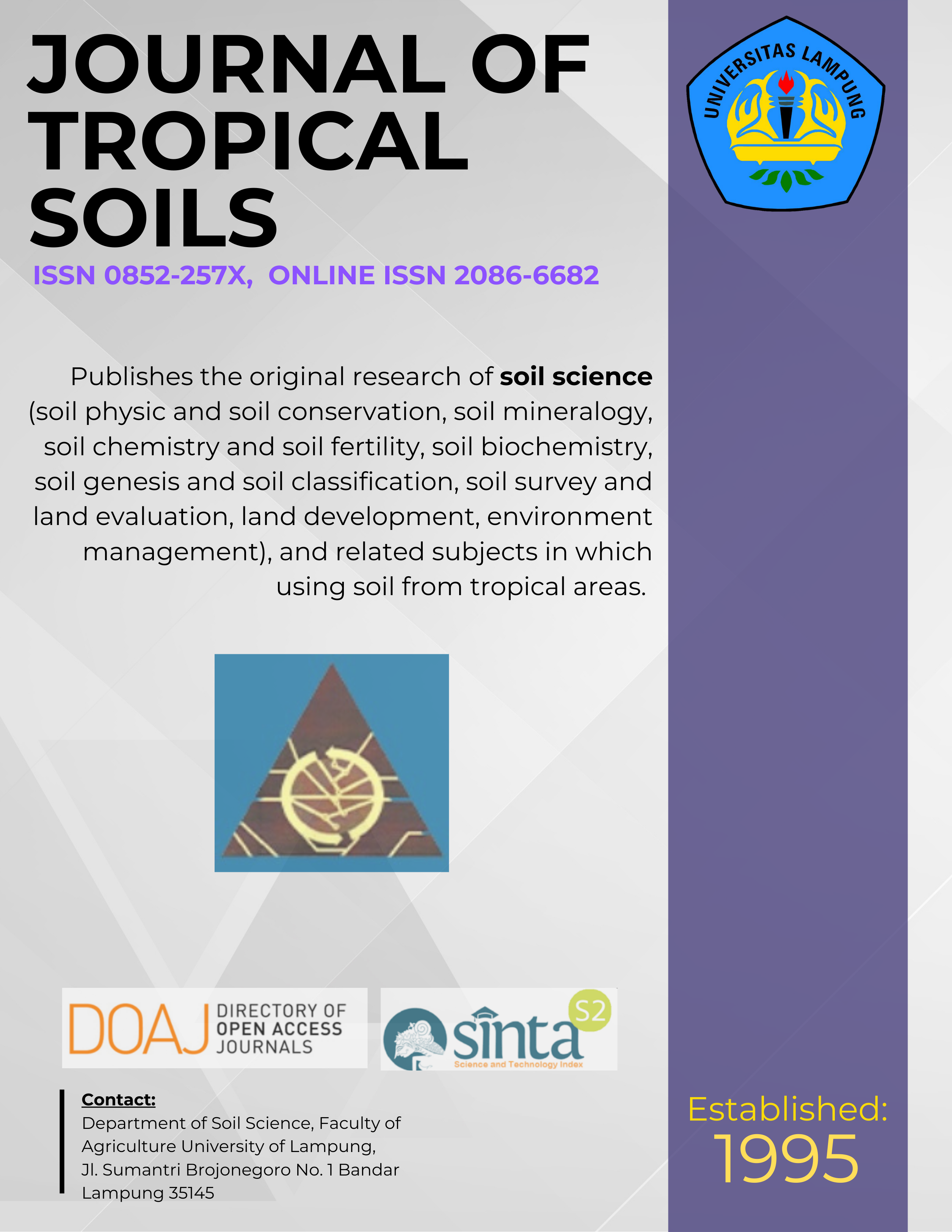The Changes of P-fractions and Solubility of Phosphate Rock in Ultisol Treated by Organic Matter and Phosphate Rock
Main Article Content
Abstract
Phosphorus (P) is one of the essential elements for plant, however, its availability is mostly very low in acid soils. It is well documented that application of phosphate rock and organic matter are able to change the level of availability of P-form in acid soils. The objective of the research were to evaluate the changes of P-fractions ( resin-P, NaHCO3-Pi, and NaHCO3-Po) and phosphate rock dissolution which were induced by application of organic matter (Imperata cylindrica, Pueraria javanica, dan Colopogonium mucunoides) and phosphate rock in Utisol Lampung. The experiment was designed in a completely randomized design with three factors and three replications. The first factor was the types of organic matter (I. cylindrica, P. javanica, and C. mucunoides), the second factor was the rate of organic matter (0, 2.5, and 5%), and the third factor was the rate of phosphate rock (0, 40, and 80 mg P kg-1). The results showed that in the rate of 0 and 1% organic matter, the type of organic matter did not affect P-fraction of NaHCO3-Pi, but in the rate of 2.5 and 5%, NaHCO3-Pi due to application of P. javanica, and C. mucunoides higher than due to application of I. cylindrica. However, the increasing rate of organic matter increased NaHCO3-Pi. Then, P-fraction of Resin-Pi was affected by the type of organic matter, the rate of organic matter, and the rate of phosphate rock, respectively. P-fraction of resin-Pi due to application of P. javanica, and C. mucunoides was higher than due to application of I. cylindrica, but the effect of P. javanica, and C. mucunoides was not different. Increasing the rate of organic matter and phosphate rock increased P-fraction of resin-Pi and NaHCO3-Pi, but P-fraction of NaHCO3-Po was not affected by all treatments. Meanwhile, dissolution of phosphate rock was affected by the kind of organic matter and soil reaction. In the rate of 5% organic matter, dissolution of phosphate rock by application of                                    I. cylindrica (70%) was higher than P. javanica (26.6%), and C. mucunoides (33.5%), but in the rate of 1%, the effect of I. cylindrica , P. javanica, and C. mucunoides were not different.
Keywords: C. mucunoides; I. cylindrica; P. javanica; phosphate rock; P-fractions
[How to Cite: Djuniwati S, B Nugroho, and HB Pulunggono. 2012. The Changes of P-fractions and Solubility of Phosphate Rock in Ultisol Treated by Organic Matter and Phosphate Rock. J Trop Soils, 17: 203-210. doi: 10.5400/jts.2012.17.3.203]
[Permalink/DOI: www.dx.doi.org/10.5400/jts.2012.17.3.203]Downloads
Article Details
Section
License for Authors
Authors who publish with this journal agree to the following terms:
- Authors retain copyright and grant the journal right of first publication with the work simultaneously licensed under a Creative Commons Attribution License that allows others to share the work with an acknowledgement of the work's authorship and initial publication in this journal.
- Authors are able to enter into separate, additional contractual arrangements for the non-exclusive distribution of the journal's published version of the work (e.g., post it to an institutional repository or publish it in a book), with an acknowledgement of its initial publication in this journal.
- Authors are permitted and encouraged to post their work online (e.g., in institutional repositories or on their website) prior to and during the submission process, as it can lead to productive exchanges, as well as earlier and greater citation of published work (See The Effect of Open Access).
License for Regular Users
Other regular users who want to cite, distribute, remix, tweak, and build upon author’s works, even for commercial purposes, should acknowledge the work’s authorship and initial publication in this journal, licensed under a Creative Commons Attribution License.

